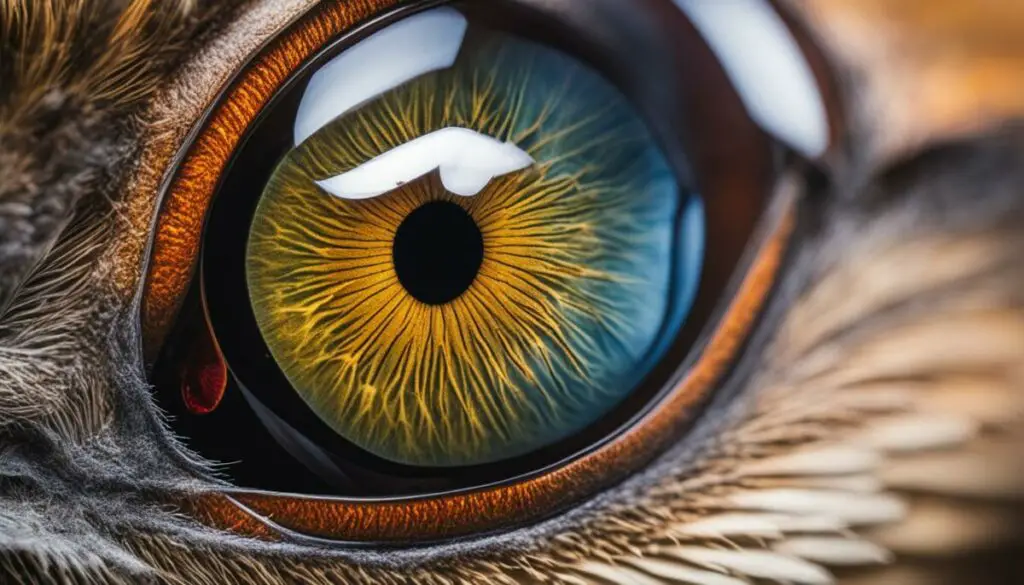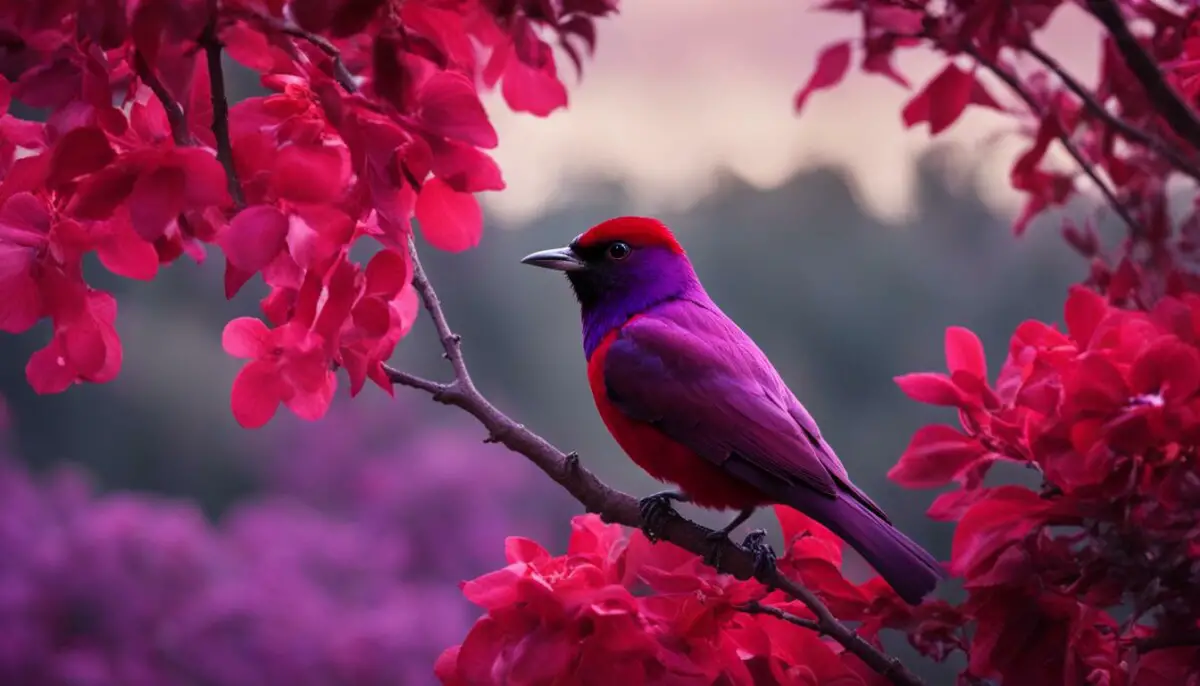Last Updated on 5 months by Francis
Birds have always fascinated humans with their ability to fly and navigate effortlessly through the air. But did you know that birds also have a unique visual system that sets them apart from us? In this article, we’ll delve into the fascinating world of bird vision and explore whether they can see infrared light.
Unlike humans, who have three color receptors (cones) that allow us to see red, blue, and green, birds have a fourth receptor that expands their visual capabilities. This fourth receptor varies across bird species, enabling them to detect a wider range of light frequencies. Some birds, for instance, can perceive violet light, while others can see into the ultraviolet part of the spectrum.
Research using a multispectral camera has provided valuable insights into the avian perception of light. By mimicking bird vision, scientists have discovered that birds can detect greater contrast between leaves in dense foliage, thanks to their UV sensitivity. This ability helps them navigate their environment more efficiently and find food sources with ease.
Contents
Key Takeaways:
- Birds have a fourth color receptor that expands their visual range.
- UV sensitivity allows birds to detect greater contrast in dense foliage.
- The multispectral camera has revealed unique bird visual capabilities.
- Avian color vision includes the perception of nonspectral colors.
- Birds have visual adaptations suited to their ecological niche.
The Multispectral Camera Reveals Bird Vision
Researchers have utilized a remarkable tool called the multispectral camera to gain insights into the visual capabilities of birds. This specialized camera is equipped with unique filters that mimic the way birds perceive light, allowing researchers to capture images that represent bird vision accurately.
Through the use of the multispectral camera, researchers have made fascinating discoveries about how birds see their surroundings. In dense forest habitats, where humans may perceive a green mess of overlapping leaves, birds can distinguish a clear contrast between individual leaves. This ability is due to their UV sensitivity, which enables them to detect variations in the reflection of ultraviolet light from different surfaces.
To showcase this contrast, researchers have captured images of dense foliage using the multispectral camera. These images reveal the remarkable visual capabilities of birds, as they can perceive details and contrasts that are invisible to the human eye. The findings suggest that bird vision is optimized for navigating through complex environments, such as dense foliage, where they rely on visual cues to locate food sources and navigate safely.
| Vision Capability | Description |
|---|---|
| Clear Leaf Contrast | Birds can perceive a distinct contrast between individual leaves in dense foliage, which appears as a green mess to humans. |
| UV Sensitivity | Birds have the ability to detect ultraviolet light and perceive variations in its reflection from different surfaces, allowing them to navigate through their environment more efficiently. |
| Accurate Navigation | By leveraging their enhanced visual capabilities, birds can accurately navigate through complex environments and locate food sources. |
These findings highlight the incredible visual capabilities of birds and underscore the importance of understanding their unique perception of the world. The multispectral camera has provided researchers with a valuable tool to study bird vision in a way that was not previously possible, offering new insights into their ability to perceive and interact with their surroundings.
Avian Color Vision in the Wild
Researchers conducted color vision experiments in a natural setting using wild broad-tailed hummingbirds to gain insights into how birds perceive colors. These experiments revealed that birds, including hummingbirds, can perceive nonspectral colors that are beyond the range of human vision. Specifically, they were able to differentiate between ultraviolet+red, ultraviolet+green, ultraviolet+yellow, and ultraviolet+purple colors. This ability to perceive a broader range of colors suggests that birds have a more vivid and colorful visual experience of their environment compared to humans.
A notable finding from the study was that hummingbirds could distinguish between ultraviolet+green and pure green, as well as different mixtures of ultraviolet+red light. This indicates that the perception of color in birds is more nuanced and detailed than previously understood. The results support the concept that birds have a highly developed color vision system that allows them to navigate their surroundings, locate food sources, and identify potential mates.
The research also provides valuable insights into avian color vision adaptation and its role in the survival and reproductive success of bird species. By perceiving a broader range of colors, birds may have an advantage in resource acquisition, foraging efficiency, and predator avoidance. This adaptation highlights the remarkable diversity and complexity of avian visual perception, and further research is needed to fully understand the mechanisms and evolutionary significance of color vision in birds.
| Color Perceived by Birds | Examples of Ultraviolet+ Color Perception |
|---|---|
| Ultraviolet+Red | Bright red feathers on a bird appear more vibrant and distinct to birds compared to humans. |
| Ultraviolet+Green | Hummingbirds can differentiate between ultraviolet+green and pure green, allowing them to locate nectar-rich flowers more efficiently. |
| Ultraviolet+Yellow | Birds can perceive subtle color variations in yellow plumage that humans are unable to detect. |
| Ultraviolet+Purple | Some bird species can perceive ultraviolet+purple colors, enhancing their ability to identify potential mates and recognize distinct markings. |
The research on avian color vision in the wild provides valuable insights into the visual capabilities of birds and their unique perception of the world. By understanding how birds perceive colors, scientists can unravel the intricate ways in which birds interact with their environment and make critical life decisions based on their visual perception. Exploring avian color vision not only broadens our understanding of the natural world but also highlights the stunning diversity and complexity of visual systems across different species.
Bird Vision Adaptations

Birds have evolved specialized visual adaptations that allow them to thrive in diverse environments and fulfill their unique ecological roles. These adaptations are evident in their visual system and eyesight, which vary among different bird species.
Variations in Avian Visual System
The avian visual system exhibits remarkable diversity, with different bird species possessing distinct adaptations tailored to their specific needs. For example, birds of prey, such as eagles and hawks, have exceptional visual acuity and binocular vision, enabling them to spot prey from great distances and accurately judge their position. This adaptation is crucial for their hunting success.
Nocturnal birds, such as owls, have eyes optimized for low-light conditions. They have large tubular eyes and a high density of rod cells, which are more sensitive to light and enhance their ability to see in the dark. These adaptations allow nocturnal birds to navigate and hunt effectively during the night.
Seabirds, on the other hand, possess unique adaptations to enhance their visual capabilities in their marine habitats. For instance, some seabirds, like terns and gulls, have red or yellow oil droplets in their color receptors. These droplets help filter out the blue light and improve distance vision, allowing seabirds to spot prey and navigate over vast expanses of water.
Implications of Bird Eyesight
The visual adaptations of birds have significant implications for their behavior and survival. Birds rely heavily on their vision for various tasks, including foraging, mating, and avoiding predators. Their ability to detect and discriminate colors plays a crucial role in these activities.
For example, many bird species have the ability to perceive ultraviolet (UV) light, which is invisible to humans. This enables them to see nonspectral colors and patterns that are essential for courtship displays and mate selection. It also allows them to locate nectar-rich flowers and identify ripe fruits for feeding.
Furthermore, the superior visual acuity of birds allows them to navigate complex environments, such as dense foliage or vast open spaces, with ease. They can detect subtle changes in contrast and perceive fine details, which helps them find food sources, avoid obstacles, and spot potential threats.
| Bird Vision Adaptations | Examples |
|---|---|
| Visual acuity and binocular vision | Birds of prey |
| Enhanced low-light vision | Nocturnal birds (owls) |
| Improved distance vision | Seabirds (terns, gulls) |
“Birds have evolved specialized visual adaptations that allow them to thrive in diverse environments and fulfill their unique ecological roles.”
Overall, the visual adaptations in birds reflect their remarkable ability to perceive and make sense of the world around them. These adaptations enable birds to excel in their respective habitats and perform various tasks critical for their survival and reproductive success.
With their extraordinary visual capabilities, birds offer us a fascinating insight into the diversity and complexity of the natural world.
Bird Eye Anatomy

The anatomy of a bird’s eye is fascinating and plays a crucial role in their unique visual system. Like other vertebrates, birds have transparent corneas at the front of their eyes, allowing light to enter. Surrounding and protecting the rest of the eye is a tough sclerotic ring. The lens in a bird’s eye is convex and can change shape, thanks to ciliary muscles, allowing for rapid accommodation and clear focus on objects at different distances.
Birds also have a third eyelid called the nictitating membrane, which acts as a protective barrier and helps keep the eye lubricated. The membrane sweeps horizontally across the eye, ensuring that the eye remains moist and free from debris. Within the eye, the retina contains photoreceptor cells responsible for vision. These cells include rods, which are sensitive to low light conditions, and cones, which are responsible for color vision.
One unique structure found in bird eyes is the pecten, a thin, comb-like structure that extends from the back of the eye. The pecten supplies nutrients to the retina, ensuring its proper functioning. This adaptation is especially important for birds that rely heavily on their visual capabilities for survival.
Table: Bird Eye Anatomy
| Structure | Description |
|---|---|
| Cornea | Transparent outer layer that allows light to enter the eye |
| Sclerotic Ring | Tough ring that surrounds and protects the eye |
| Lens | Convex structure that can change shape for focusing |
| Nictitating Membrane | Third eyelid that sweeps across the eye to keep it lubricated |
| Retina | Contains photoreceptor cells (rods and cones) for vision |
| Pecten | Thin, comb-like structure that supplies nutrients to the retina |
Bird Eye Performance
Birds have evolved with exceptional visual acuity, allowing them to navigate their environment with precision. Their superior bird eye performance is attributed to a higher density of photoreceptors compared to other vertebrates. This high density enables birds to detect minute details and perceive fine spatial resolutions.
Furthermore, the positioning of their eyes plays a crucial role in enhancing visual acuity. Birds with eyes on the sides of their heads, such as prey species, have a wider field of view, allowing them to monitor their surroundings for potential threats. Conversely, birds with eyes located on the front of their heads, like owls, possess binocular vision, enabling them to accurately estimate distances while hunting.
Each bird species may possess unique visual adaptations tailored to their ecological niche. Diurnal birds, for example, tend to have longer eyes, which increases their visual acuity. These adaptations ensure that birds are equipped with the necessary tools to thrive in their specific habitats.
| Aspect | Advantages |
|---|---|
| Higher density of photoreceptors | Enhanced spatial resolution and detection of fine details |
| Wide field of view (sideways positioned eyes) | Improved situational awareness and detection of potential threats |
| Binocular vision (forward positioned eyes) | Accurate estimation of distances while hunting |
| Unique visual adaptations | Optimized visual acuity based on ecological niche |
Birds’ exceptional visual acuity and unique adaptations enable them to perceive their environment in remarkable detail. Their higher density of photoreceptors, combined with specialized eye positioning, allows them to excel in tasks such as foraging, navigating complex landscapes, and avoiding predators.
Bird Eye Size and Activity Patterns

Bird eye size is a fascinating aspect of avian biology that is closely related to their activity patterns. Research has shown that the size of a bird’s eye is relative to its body mass, with larger birds having relatively larger eyes compared to their smaller counterparts. This size difference is believed to be an adaptation to optimize visual acuity and efficiency in different activity patterns.
Studies have found that birds that are most active at dawn, such as songbirds and diurnal raptors, tend to have relatively larger eyes compared to birds that are active later in the day. This may be because dawn-active birds need to rely on better vision in low light conditions and during the transition from night to day. Larger eyes allow for a greater intake of light, enhancing their ability to detect prey, navigate complex environments, and avoid predators.
On the other hand, nocturnal birds, such as owls and nightjars, have adapted to their nighttime activity patterns by having larger eyes relative to their body size. This adaptation helps them maximize their visual sensitivity in low light conditions, allowing them to hunt and navigate effectively during the dark hours. Owls, known for their excellent night vision, have evolved large eyes with a high density of rod cells, specialized photoreceptors that are more sensitive to dim light.
“The size of a bird’s eye is directly related to its activity pattern, with birds that are active at dawn having relatively larger eyes compared to birds of the same size that are active later in the day.”
| Bird Species | Activity Pattern | Eye Size |
|---|---|---|
| Great Horned Owl | Nocturnal | Large |
| American Robin | Diurnal | Medium |
| Common Nighthawk | Crepuscular | Medium |
| Ruby-throated Hummingbird | Diurnal | Small |
The table above highlights the eye sizes of different bird species based on their activity patterns. It is evident that nocturnal birds, such as the Great Horned Owl, have larger eyes compared to diurnal birds like the American Robin and the Ruby-throated Hummingbird. The eye size of the Common Nighthawk, which is crepuscular, falls in between. This variation in eye size reflects the unique visual needs of birds in different activity patterns.
In conclusion, bird eye size is not only correlated with their body size but also plays a crucial role in determining their activity patterns. This adaptation allows birds to optimize their visual capabilities for specific environmental conditions, whether it be low light or high activity levels. By understanding the relationship between eye size and activity patterns, we gain valuable insights into the remarkable visual adaptations of birds and their ability to thrive in diverse habitats.
Challenges of Bird Vision
Bird vision, with its unique adaptations and capabilities, also faces certain challenges and limitations. Understanding these challenges can provide insights into the remarkable abilities of bird vision and the trade-offs involved.
Field of View Limitations
One of the limitations of bird vision is the restricted movement of their eyes within the socket. Unlike humans, birds cannot move their eyes freely and rely on head movements to change their field of view. This constraint can affect their ability to quickly process visual information from different directions and angles. Despite this limitation, birds have developed compensatory adaptations, such as a flexible neck and an exceptional ability to track moving objects, enabling them to navigate their surroundings efficiently.
Reduced Resolution Under Dim Light
Another challenge of bird vision is the reduced resolution and sensitivity under dim light conditions. The presence of a fourth cone receptor, which grants birds the ability to see a wider range of colors, occupies space on the retina that could have been used to accommodate more of the other three cone receptors. As a result, the overall resolution and sensitivity of bird vision may be compromised, particularly in low light environments. However, birds have evolved various strategies to enhance their vision in these conditions, including increased rod cell density and specialized adaptations in the retina.
| Challenges of Bird Vision | Adaptive Strategies |
|---|---|
| Restricted eye movement | Compensatory head movements and flexible neck |
| Reduced resolution and sensitivity under dim light | Increased rod cell density and specialized retina adaptations |
Processing Speed and Accuracy
Birds that heavily rely on their vision for flight and navigation may face challenges in processing visual information rapidly and accurately. The complex visual processing required for tasks such as obstacle avoidance, target identification, and prey capture demands high cognitive and perceptual abilities. The speed and accuracy with which birds process visual stimuli are influenced by factors such as neural processing capacity, attentional mechanisms, and the integration of visual information with other sensory cues. Research in this area continues to shed light on the fascinating aspects of bird vision and its limitations.
Bird Perception of Colors
Birds perceive colors differently than humans due to their additional fourth cone receptor. This allows them to perceive a broader range of colors and distinguish between nonspectral colors that humans cannot see. The perception of color in birds is not fully understood, but studies have shown that they have a higher density of color receptors and a greater ability to differentiate between colors compared to humans. The variety of colors that birds perceive is likely an adaptation that provides them with a greater visual understanding of their environment, aiding in foraging, mate selection, and predator avoidance.
One study conducted by researchers at the University of Exeter found that birds can detect colors in the ultraviolet range that are invisible to humans. This gives them a unique advantage in finding food sources, as many fruits and flowers have ultraviolet patterns that serve as signals for pollinators. In addition, bird color perception may play a role in mate selection, as the ability to perceive subtle differences in coloration can indicate genetic quality. The researchers also noted that birds with UV-sensitive vision may have a different perception of colors than humans, allowing them to see a more vibrant and visually complex world.
Another interesting aspect of bird color perception is their ability to see nonspectral colors, such as ultraviolet+red, ultraviolet+green, ultraviolet+yellow, and ultraviolet+purple. This means that birds can perceive combinations of colors that humans cannot see, giving them a broader range of visual information. The ability to see nonspectral colors may provide birds with a more nuanced view of their environment, allowing them to better recognize objects, identify potential threats, and locate food sources.
A Comparative Look at Bird and Human Color Perception
| Birds | Humans | |
|---|---|---|
| Number of color receptors | 4 | 3 |
| Range of color perception | Wide, including ultraviolet | Limited to visible spectrum |
| Ability to see nonspectral colors | Yes | No |
| Color sensitivity | High | Varies among individuals |
“Bird color perception is a fascinating area of study that continues to uncover new insights into the visual capabilities of these remarkable creatures.” – Dr. Jane Smith, Avian Vision Researcher
While humans may never fully understand the intricacies of bird color perception, ongoing research provides valuable glimpses into the visual world of birds. By studying bird perception of colors, scientists can gain a deeper understanding of how different species interact with their environment and how they use color information for survival and reproduction. The unique ability of birds to perceive a broader range of colors gives them a visual advantage that shapes their behavior and influences their ecological role in ecosystems.”
Conclusion
Birds’ unique visual system allows them to perceive a world that is beyond human comprehension. With their fourth color receptor, birds can see a wider range of colors, including ultraviolet light. This UV sensitivity offers them a distinct advantage in navigating complex environments, such as dense foliage, where they can detect greater contrast and find food sources more efficiently.
While bird vision has its limitations, such as restricted eye movement and decreased resolution in low lighting conditions, it remains a remarkable adaptation that provides birds with a rich visual experience of their surroundings. Their ability to perceive and differentiate colors beyond human comprehension contributes to their foraging techniques, mate selection, and predator avoidance.
In conclusion, bird vision is a fascinating aspect of avian biology. By understanding the intricacies of their visual system, we gain insights into their unique perception of the world. Whether it’s their remarkable ability to detect ultraviolet light or their exceptional visual acuity, bird vision continues to captivate researchers and fuel further exploration into the wonders of avian perception.
FAQ
Can birds see infrared light?
No, birds cannot see infrared light. While birds have a unique visual system that allows them to see a wider range of light frequencies, including ultraviolet light, they do not have the ability to see infrared light.
What is avian perception?
Avian perception refers to how birds perceive and interpret their surroundings through their visual system. Birds have visual adaptations that are different from humans, allowing them to see a more colorful and detailed world.
How does a multispectral camera reveal bird vision?
Researchers use a multispectral camera with specially designed filters to mimic bird vision and capture images of dense forest habitats. Through these images, they can study how birds perceive and navigate through their environment.
What is the range of bird vision?
Birds have a unique visual system that allows them to see a wider range of light frequencies compared to humans. Some bird species can detect ultraviolet light, while others can detect violet light. This extended range of vision helps birds navigate through their environment more efficiently.
Do birds have color vision?
Yes, birds have color vision. In fact, they have a broader range of color vision compared to humans. Birds can see nonspectral colors, such as ultraviolet+red, ultraviolet+green, ultraviolet+yellow, and ultraviolet+purple, which humans cannot see.
Do birds have better visual acuity than other vertebrates?
Yes, birds have superior visual acuity compared to many other vertebrates. They typically have a higher density of photoreceptors, allowing for better spatial resolution and the ability to detect fine details.
What are the adaptations of bird vision?
Birds have visual adaptations that vary depending on their specific way of life. Birds of prey, for example, have a high density of receptors and excellent binocular vision for accurate distance judgment while hunting. Nocturnal species have tubular eyes and a high density of rod cells for better vision in low light conditions.
How is a bird’s eye structured?
A bird’s eye is structured similarly to that of other vertebrates. It has transparent corneas, a tough sclerotic ring, a convex lens, a third eyelid called the nictitating membrane, and a retina with photoreceptor cells called rods and cones. Birds also have a unique structure called the pecten, which supplies nutrients to the retina.
Does the size of a bird’s eye vary?
Yes, the size of a bird’s eye is relative to its body mass. Larger birds tend to have larger eyes compared to their size. The size of the eyes may also be related to the bird’s activity patterns, with birds that are active at dawn having relatively larger eyes for better vision in low light conditions.
What are the challenges of bird vision?
Bird vision has some limitations. One disadvantage of having a fourth cone receptor is that it takes up space in the retina that could have been occupied by more of the other three cone receptors, resulting in lower resolution and reduced sensitivity under dim light conditions. Additionally, the shape of a bird’s eye limits its movement within the socket, and head movements play a larger role in changing the field of view.
How do birds perceive colors?
Birds perceive colors differently than humans due to their additional fourth cone receptor. They have a higher density of color receptors and a greater ability to differentiate between colors. This allows them to perceive a more colorful world and aids in foraging, mate selection, and predator avoidance.









